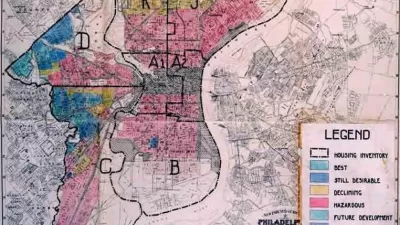According to a new report detailing discriminatory lending in Chicago, people in majority-white neighborhoods continue to receive more loans, and in greater amounts, than people in majority-Black and majority-Latino areas.

New analysis from WBEZ and City Bureau shows the massive disparity in lending to residents of white neighborhoods compared to residents of black and Latino neighborhoods in Chicago. Linda Lutton, Andrew Fan, and Alden Loury call the practice "Modern-day redlining," describing "a pattern that locks residents out of home ownership, deprives communities of desperately needed capital investment and threatens to exacerbate racial inequities between neighborhoods."
When WBEZ and nonprofit newsgroup City Bureau reviewed 168,859 home loans between 2012 and 2018 made by banks and non-bank mortgage companies, they found that of the $57.4 billion loaned, 68.1% of cash funded people in majority-white neighborhoods with only 8.1% going to majority-black neighborhoods and 8.7% ending up in majority-Latino neighborhoods. Their report notes that while higher home prices in majority-white neighborhoods can explain part of the imbalance, the fact that "financial institutions made four times more loans in Chicago’s white neighborhoods than they did in black or Latino areas" obviously points to a much larger problem.
According to the authors, injecting money into neighborhoods in the form of home loans is a fundamental way to impact the health of communities and the quality of life of its residents.
FULL STORY: Where Banks Don’t Lend

Alabama: Trump Terminates Settlements for Black Communities Harmed By Raw Sewage
Trump deemed the landmark civil rights agreement “illegal DEI and environmental justice policy.”

Planetizen Federal Action Tracker
A weekly monitor of how Trump’s orders and actions are impacting planners and planning in America.

The 120 Year Old Tiny Home Villages That Sheltered San Francisco’s Earthquake Refugees
More than a century ago, San Francisco mobilized to house thousands of residents displaced by the 1906 earthquake. Could their strategy offer a model for the present?

In Both Crashes and Crime, Public Transportation is Far Safer than Driving
Contrary to popular assumptions, public transportation has far lower crash and crime rates than automobile travel. For safer communities, improve and encourage transit travel.

Report: Zoning Reforms Should Complement Nashville’s Ambitious Transit Plan
Without reform, restrictive zoning codes will limit the impact of the city’s planned transit expansion and could exclude some of the residents who depend on transit the most.

Judge Orders Release of Frozen IRA, IIJA Funding
The decision is a victory for environmental groups who charged that freezing funds for critical infrastructure and disaster response programs caused “real and irreparable harm” to communities.
Urban Design for Planners 1: Software Tools
This six-course series explores essential urban design concepts using open source software and equips planners with the tools they need to participate fully in the urban design process.
Planning for Universal Design
Learn the tools for implementing Universal Design in planning regulations.
Clanton & Associates, Inc.
Jessamine County Fiscal Court
Institute for Housing and Urban Development Studies (IHS)
City of Grandview
Harvard GSD Executive Education
Toledo-Lucas County Plan Commissions
Salt Lake City
NYU Wagner Graduate School of Public Service





























